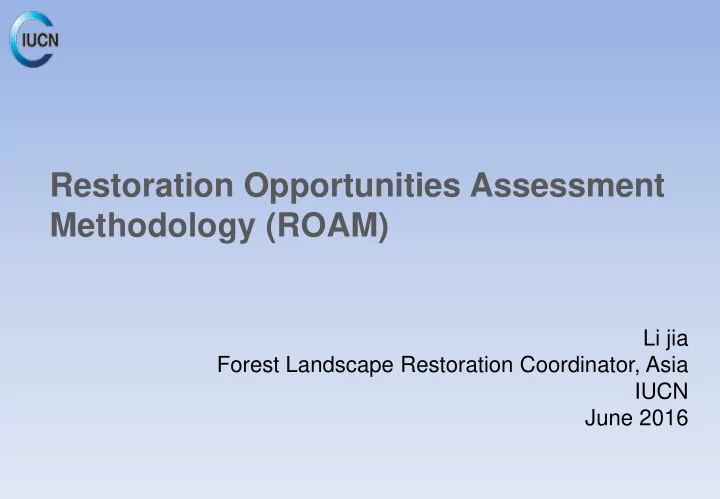

Restoration Opportunities Assessment Methodology (ROAM) Li jia Forest Landscape Restoration Coordinator, Asia IUCN June 2016
Estimated that more than 2 billion hectares may have opportunity for restoration 2
But how do we assess forest and landscape restoration opportunities? And where do we start?
One way forward is the Restoration Opportunities Assessment Methodology (ROAM) Getting Started Allianz Knowledge Site GBI Portal Collecting Sharing data results Analysis and mapping
1. Preparation and planning 2. Data collection and analysis 3. Results to recommendations
Phase 1. Preparation and planning
Defining the scope of the assessment • Stocktaking • Scoping FLR (objectives) • Defining the problem and opportunities • Understanding the drivers of degradation Right: Potential contributions of FLR interventions to national development targets in Rwanda
Phase 2. Data collection and analysis
Key aspects of ROAM – FLR prioritization Determine indicators Degradation map or proxies for degradation Multi-criteria Relevant to scope of degradation maps the assessment! Socio-economic / FLR priority map bio-physical data
FUNCTIONAL LAND DEGRADATION = Loss of support function of the land (ecosystem services) + Level of fragmentation and land pressure + Diminished carbon sequestration Level of functional land degradation (ha) in the Yucatán península Quintana Roo Yucatán Campeche Very high 114,365 446,338 285,284 High 231,301 632,194 462,250 Medium 500,018 925,328 842,507 Low 1,515,095 1,237,034 1,616,788 Very low 1,881,192 2,313,210 548,633
Data collection Data & Mapping Stakeholder consultations
Key aspects of ROAM – FLR opportunities Identify potential FLR Current land-use opportunities based on map current land-use and multi-criteria degradation map (FLR FLR priority map priority map) FLR opportunities
Restoration Economic Modeling and Valuation Computing the marginal values of restoration interventions
Key aspects of ROAM – FLR transitions & technical packages Analyze FLR transitions, Analysis of FLR to identify the best transitions social, economic and ecological FLR strategies. FLR strategies Analysis: Diagnostic, identified Valuation, Carbon, CBA, Ecosystem service modelling, e.g InVest and use decision support FLR technical tools such as ROOT. packages developed
FLR potential to: ( A) increase carbon storage (B) improve water quality (C) conserve biodiversity (D) maintain agricultural production Purple low, Green high
ROOT R estoration O pportunities O ptimization T ool Decision support tool to optimize a combination of two services or goods.
Cost Benefit Analysis Agroforestry Woodlots Natural regeneration Discount 10% 16% 10% 16% 10% 16% Rate Value Value Value Value Value Value (UGX) (UGX/Ha) (UGX/Ha) (UGX/Ha) (UGX/Ha) (UGX) Present Value of 1,274,893 908,642 5,377,609 3,567,785 94,269 61,772 Costs Present Value of 17,334,162 8,135,547 7,993,122 4,502,454 2,967,154 1,542,919 Benefits NPV 16,059,269 7,226,905 2,615,513 934,669 2,872,885 1,481,147 Benefit Cost Ratio 13.60 8.95 1.49 1.26 31.48 24.98
Carbon Modeling Result of cost-benefit-carbon modelling undertaken in Ghana assessment
Restoration Diagnostic of Key Success Factors
Phase 3. Results to recommendations
Organizing the validation workshop
FLR finance and scaling up Determine the business Business models models for financing (bankable proposals) Look at private sector, public sector, Unlocking finance investment and donor community. Scaling-up and uptake into policies/legislation
Application of ROAM Ghana – baseline-setting supporting Ghana’s • Forest Investment Program (FIP) Mexico - contribute a cross-institutional • national restoration strategy Rwanda – define a strategy to realize the • commitment of 2 million ha to the Bonn Challenge Guatemala – foundation for the 1 st national • restoration strategy; and, the re-shaping of reforestation incentive schemes
Summary • ROAM is the most comprehensive and responsive framework for Forest Landscape Restoration • The key inputs of ROAM are stakeholder engagement and ownership in: – preparation and planning – data collection & analysis – validation of the results • Key outputs of ROAM are: – Implementation of FLR and uptake into policy and legislation – Unlocking finance • The results of ROAM facilitate local, sub-national, national and international processes and the methodology is resilient to different scales. • The ROAM framework is not prescriptive, but procedural , allowing stakeholders to guide and inform Forest Landscape Restoration decision- making at each step and build local ownership underneath a global movement.
For more information, contact Li Jia Jia.li@iucn.org Forest Landscape Restoration Coordinator, Asia IUCN, International Union for Conservation of Nature
Recommend
More recommend